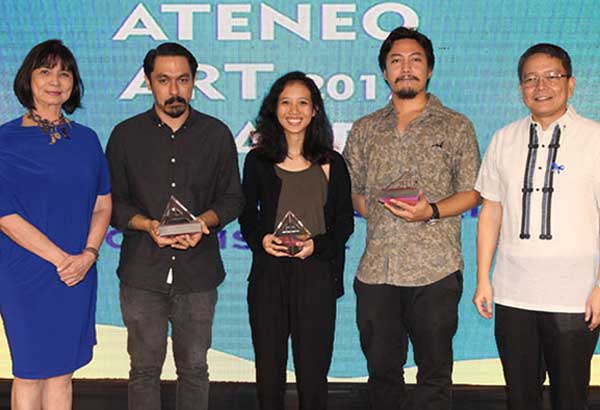At Areté, Ateneo Art Awards marks a turn


The STAR Lifestyle editor Millet Mananquil and Ateneo de Manila University president Fr. Jose Ramon “Jett” Villarin flank the winners of the Ateneo Art Awards-Fernando Zobel Prizes for Visual Art: Costantino Zicarelli, Gale Encarnacion, and Cian Dayrit. Photos by JOEY VIDUYA
When the Ateneo Art Awards (AAA) was held recently to herald a new set of winners for its 14th iteration, part of the energy of the crowd came from finally seeing and stepping inside Areté after much anticipation. Providing a powerful context to the award that has long been regarded as one of the most prestigious in the country, it is Ateneo de Manila University’s (AdMU) main hub devoted to the intersections of creativity, innovation, and learning — an architectural exclamation point marrying an expressive silhouette with a medley of straight lines.
It felt like the whole of the art world had descended on Areté’s main lobby ready to cheer for the shortlisted artists and writers — and the eventual winners — of AAA’s Fernando Zobel Prizes for the Visual Arts and the Purita Kalaw-Ledesma Prizes for Art Criticism. Formally welcoming guests to Areté was the AdMU president Fr. Jose Ramon “Jett” Villarin, SJ while presiding over the ceremony was Ma. Victoria “Boots” Herrera, director and chief curator of the Ateneo Art Gallery (AAG), which now calls the newest addition to the Loyola campus, from its former location at the old Rizal Library, as its new home.
For the visual art prizes, Cian Dayrit, Gale Encarnacion and Costantino Zicarelli, who each scored an artist residency, emerged as the winners among the shortlisted artists that included Catalina Africa, Charles Buenconsejo, Gino Bueza, Zean Cabangis, Kitty Kaburo, Doktor Karayom, Czar Kristoff, Leonardo Onia Jr., and Nicole Tee.
“Among the shortlisted exhibitions this year, eight out of 12 artists are included for the first time — evidence of the continuing growth of visual art practice in the country,” said Herrera. “Through different modes, they find inspiration in everyday existence and in the ironies of survival in today’s precarious world.”
Arianna Mercado and Josephine Roque, on the other hand, were declared winners of the art criticism prizes that had Christian Benitez, Carlo Pacolor Garcia, John Kenneth Paranada, and Chanon Kenji Praepipatmongkol in the shortlist. Mercado will soon write a bi-monthly column called “Platforms” for The Philippine Star while Roque will write exhibition reviews for Art Asia Pacific, a Hong Kong-based publication focused on contemporary Asian art.
In establishing the awards along with AAG and its media partners, “Our main objective from the very beginning,” said Ada Ledesma-Mabilangan, director of Purita Kalaw-Ledesma Foundation, “was to encourage and develop writers by giving them a platform where they can espouse their ideas, analyze and criticize, and bring their voice into the conversation vis-à-vis Philippine art, the art scene today.”
Currently showcased in one of the exhibiting spaces of AAG, the works of the winners explored the formal and symbolic properties of materials, renegotiated personal and spatial limits, and underscored the performative and conceptual nature of the artist’s gesture frozen by inanimate objects. For instance, in her work, “Blow Me,” Encarnacion, the recipient of Artesan Gallery + Studio (Singapore) artist residency, revealed the shifting, ephemeral topography of chewed-up bubblegum suspended as skeins of gossamer-like presences or activated by breath in video channels.
Meanwhile, Dayrit, who received the La Trobe Art Institute (Bendigo, Australia) artist residency, unsettled the nature of map as an ideological space perpetuated by the colonial gaze and desire by incorporating vernacular symbols in his work “Exposition.” The Liverpool Hope University (Liverpool, United Kingdom) artist residency recipient, Zicarelli, in “Prelude to a Billion Years,” reconstituted existing imagery, such as the Ginebra San Miguel logo, into new forms of expressive inventiveness.
Their works, as well as those of the shortlisted artists, are in conversation with Mutable Truths: Perspectives in Philippine Contemporary Art Practice, an exhibition which features the works of the first 10 recipients of La Trobe University artist residency. They are Poklong Anading, Martha Atienza, Lyle Buencamino, Charles Buenconsejo, Buen Calubayan, Marina Cruz, Kawayan De Guia, Leeroy New, Mark Salvatus, and Ronald Ventura. Together, these works generate a view of the landscape of contemporary art practice — characterized by stable forms as well as seismic fault-lines — in the first two decades of the 21st century.
Fr. Villarin remarked upon “these varied approaches to art.” For him, art “is an eminent pathway to cultivating a particular set of sensitivities” as well as “a veritable lens through which we can discover ourselves, through which we can discover the truth, of which a university is a steward. I hope that in discovering ourselves and rediscovering our shared humanity, we can contribute to some kind of transformation that is needed in the world today.”



















